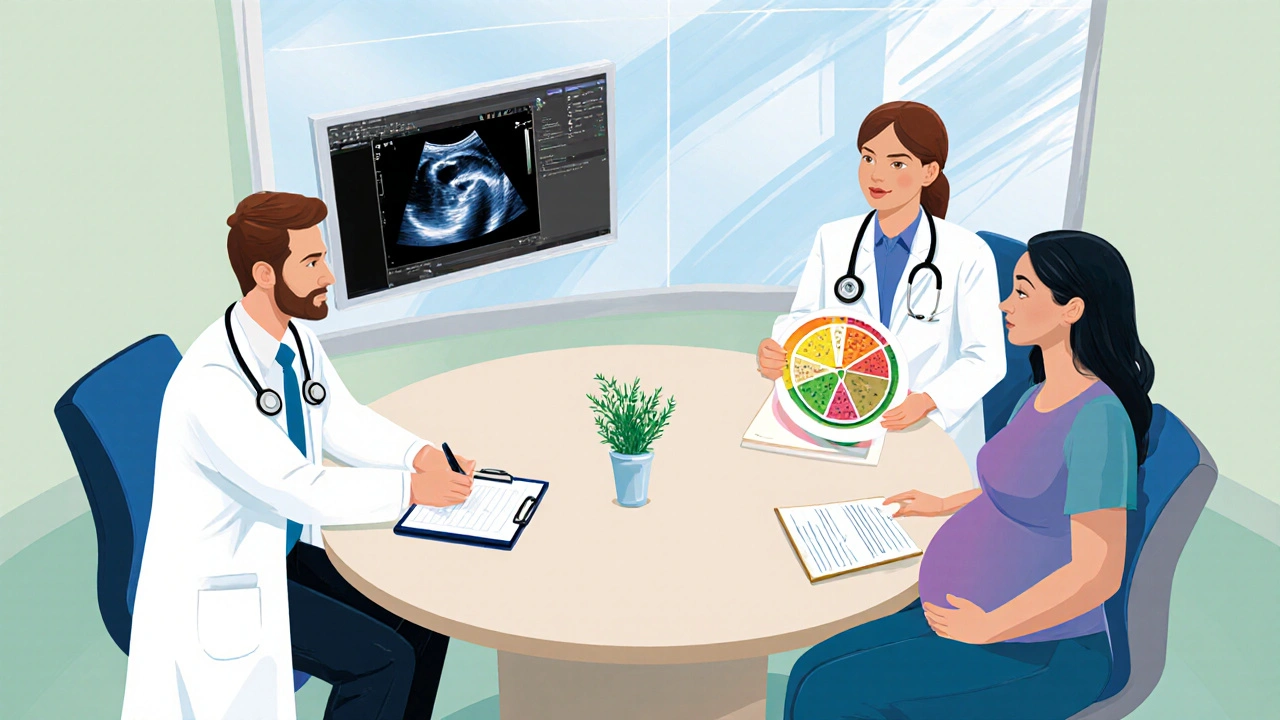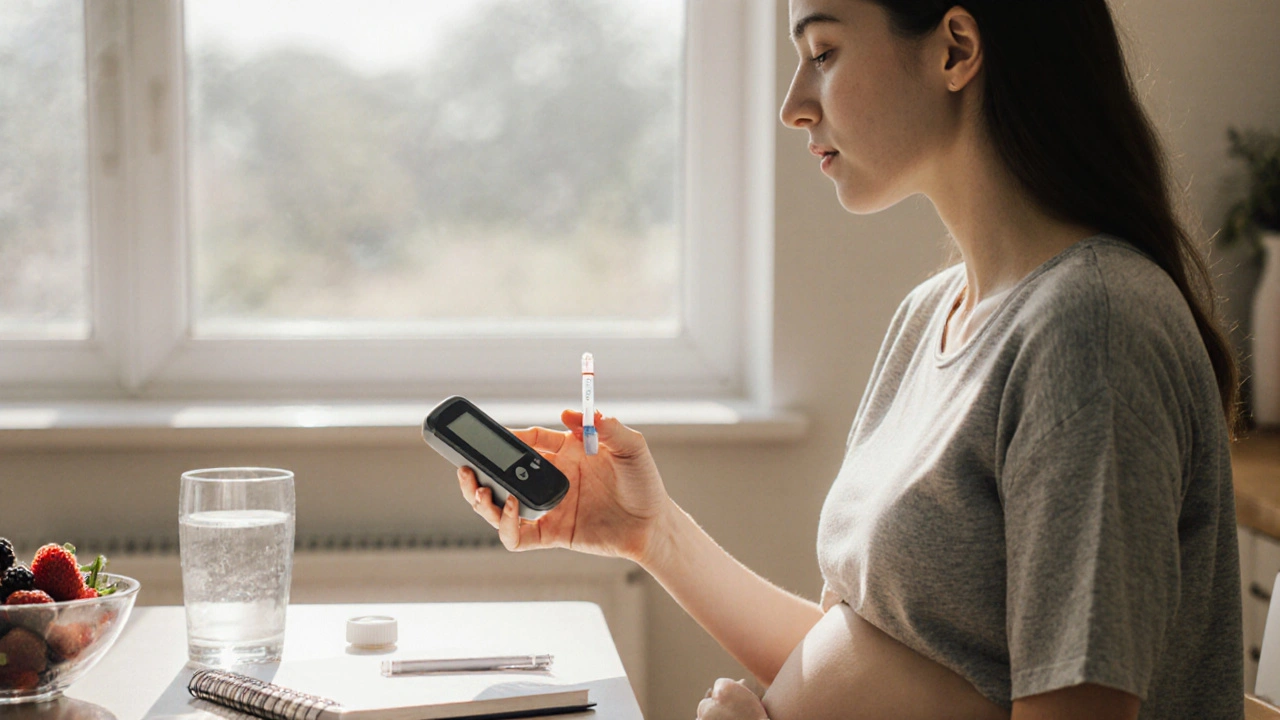Blood Glucose Target Tracker
Recommended Blood Glucose Targets During Pregnancy
Fasting: 80–110 mg/dL
1 Hour After Meals: Less than 140 mg/dL
2 Hours After Meals: Less than 120 mg/dL
Key Takeaways
- Keep blood‑glucose targets tighter than usual: 80‑110mg/dL fasting, <140mg/dL post‑meal.
- Insulin is the safest medication; most oral drugs are avoided.
- Partner with an obstetrician, an endocrinologist, and a dietitian from the start.
- Focus on balanced carbs, lean protein, and fiber‑rich veggies at every meal.
- Gentle, regular exercise and stress‑relief practices improve glucose control and mood.
Finding out you’re pregnant while living with type 2 diabetes a chronic condition that makes it harder for the body to use insulin can feel overwhelming. The good news is that with the right plan, you can protect your health and give your baby the best start. This guide walks you through the concrete steps-monitoring, medication, food, movement, and support-that turn a scary “what‑if” into a confident, everyday routine.
Understanding Type 2 Diabetes in Pregnancy
When a woman with type 2 diabetes during pregnancy experiences elevated blood‑sugar levels while carrying a baby, the risks shift. Poor control raises the chance of pre‑eclampsia, premature birth, and a larger‑than‑average baby (macrosomia). On the flip side, tight control can cut those risks dramatically and even lower the likelihood of your child developing diabetes later in life.
Build a Support Team Early
You don’t have to go it alone. A coordinated team keeps every aspect of your care in sync.
- Obstetrician a doctor who specializes in pregnancy and birth: monitors fetal growth and schedules ultrasounds.
- Endocrinologist a specialist in hormone‑related disorders, including diabetes: fine‑tunes insulin doses and reviews lab results.
- Registered dietitian a nutrition expert who creates personalized meal plans for pregnant women with diabetes: helps you balance carbs, protein, and fats without feeling hungry.
Schedule the first joint appointment by the end of the first trimester. Bring a list of all current meds, a recent HbA1c a blood test that shows average glucose over the past 2‑3 months result, and any glucose logs you already have.

Blood Glucose Monitoring Essentials
Frequent checks give you real‑time feedback. Aim for at least four readings a day: fasting, before each main meal, and at bedtime.
- Target ranges: 80‑110mg/dL fasting, <140mg/dL one‑hour post‑meal.
- Use a blood glucose monitor a handheld device that measures sugar levels from a tiny finger‑stick sample with a clear display.
- Keep a log-paper or app-and share it with your endocrinologist every two weeks.
If numbers creep high, adjust meals or insulin within 30‑60 minutes, not days. Rapid response prevents the baby’s excess glucose exposure.
Medication Management: Insulin vs. Oral Drugs
Most oral diabetes meds cross the placenta and are discouraged. Insulin remains the gold standard because it doesn’t reach the baby in harmful amounts.
| Aspect | Insulin | Oral Medications |
|---|---|---|
| Placental Transfer | Minimal - safe for baby | Variable - many cross placenta |
| Effectiveness | Highly controllable, dose‑adjustable | Less predictable in pregnancy |
| Common Types | Rapid‑acting (lispro, aspart), long‑acting (glargine, detemir) | Metformin (used only when benefits outweigh risks) |
| Side‑effects | Hypoglycemia, injection site irritation | GI upset, possible fetal growth impact |
Work with your endocrinologist to set a basal‑bolus regimen: a steady background dose plus rapid‑acting shots before meals. If you’re already on metformin, discuss whether to continue-some specialists keep it until the second trimester, then switch fully to insulin.
Nutrition and Meal Planning
Food is your biggest glucose controller. The goal is steady carbs spread throughout the day.
- Carbohydrate counting tracking grams of carbs in each meal to match insulin dose: aim for 45‑60g carbs at breakfast, 60‑75g at lunch, and 45‑60g at dinner, plus 15‑30g for each snack.
- Choose low‑glycemic foods: whole‑grain breads, beans, non‑starchy vegetables, and fresh fruit.
- Pair carbs with protein and healthy fats (nuts, avocado, olive oil) to slow absorption.
- Stay hydrated-water helps kidneys flush excess glucose.
Use the plate method: half non‑starchy veg, one‑quarter lean protein (chicken, fish, tofu), one‑quarter carbs. This visual guide keeps portions in check without endless calculations.
Safe Exercise for a Growing Belly
Movement improves insulin sensitivity and mood. Aim for 150 minutes of moderate activity each week, split into 30‑minute sessions.
- Walking briskly, swimming, or prenatal yoga are excellent low‑impact options.
- Check blood glucose before and after exercise; if it falls below 80mg/dL, have a snack ready.
- Stay cool and avoid overheating-pregnancy already raises core temperature.
Always run your workout plan by your obstetrician, especially if you develop complications like high blood pressure.

Managing Cravings, Stress, and Sleep
Hormonal shifts can spark cravings for sweets. The trick is to satisfy the urge without spiking glucose.
- Keep a stash of high‑fiber snacks (Greek yogurt with berries, hummus with carrot sticks).
- Practice deep‑breathing or a short meditation when anxiety spikes-stress hormones raise blood sugar.
- Prioritize 7‑9 hours of sleep; lack of rest increases insulin resistance.
Consider a prenatal support group-sharing experiences reduces isolation and gives practical tips from women walking the same path.
Monitoring Fetal Health
Your baby’s growth is closely linked to your glucose levels.
- Regular ultrasounds at 12, 20, and 32 weeks track size and amniotic fluid.
- Non‑stress tests (NST) in the third trimester assess the baby’s heart rate response.
- If your baby shows signs of macrosomia, your obstetrician may discuss early delivery options.
Open communication with your care team ensures any early warning signs are acted upon quickly.
Daily Checklist for Expectant Moms with Type 2 Diabetes
- Check fasting glucose as soon as you wake up.
- Log every meal’s carb count and insulin dose.
- Take a short 10‑minute walk after lunch.
- Hydrate - aim for at least 8 cups of water.
- Review glucose log with your dietitian weekly.
- Schedule next prenatal visit and ultrasound.
Frequently Asked Questions
Can I still eat fruit if I have type 2 diabetes during pregnancy?
Yes. Fruit provides essential vitamins and fiber. Choose whole fruits, count the carbs (about 15g per small apple), and balance them with protein or healthy fat to avoid spikes.
Is metformin ever safe to use while pregnant?
Some endocrinologists keep metformin through the first trimester if blood sugars are hard to control, but most switch to insulin by the second trimester because insulin has a proven safety record.
How often should I see my obstetrician?
Typical schedule: every 4 weeks until 28 weeks, every 2 weeks until 36 weeks, then weekly until delivery. Additional visits may be needed if blood sugars are unstable.
What are the warning signs of low blood sugar during pregnancy?
Symptoms include shakiness, sweating, rapid heartbeat, dizziness, or sudden hunger. If you feel any of these, treat with 15g of fast‑acting carbs (like glucose tablets) and re‑check in 15 minutes.
Can I travel during pregnancy with type 2 diabetes?
Travel is fine as long as you bring extra testing supplies, snacks for lows, and a copy of your medical records. Adjust insulin for time‑zone changes by consulting your endocrinologist before you go.

